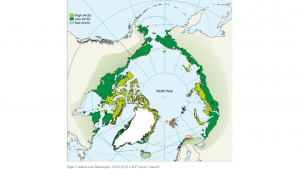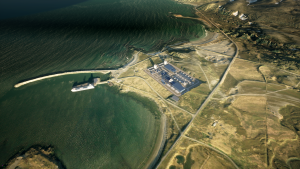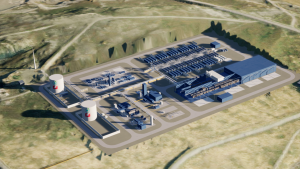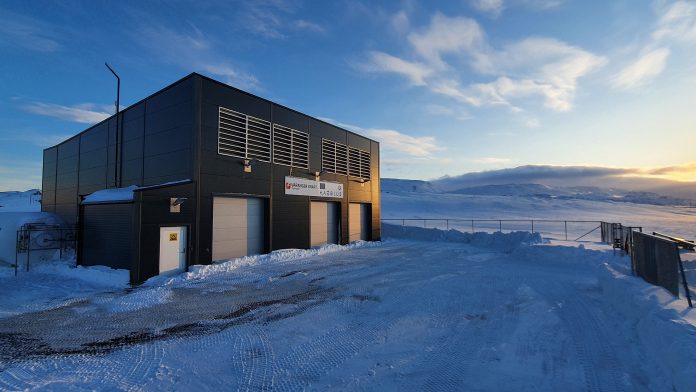Christian Bue, CEO of Green Ammonia Berlevåg, explains more about the venture aiming to bring easy access to green ammonia for the shipping industry and off-grid communities in the Arctic.
In Berlevåg in Norway, north of the Arctic circle, Aker Horizons and Varanger Kraft are developing a green ammonia production facility to provide the shipping industry and off-grid communities in the Arctic with clean energy. Through their co-owned joint venture, Green Ammonia Berlevåg (GAB), the two partners are planning to build a 100 MW green ammonia facility in the first phase, using renewable power from Varanger Kraft’s adjacent wind farm on Ràkkocearru.
To find out more about the venture and its potential, The Innovation Platform spoke to Christian Bue, CEO of Green Ammonia Berlevåg.
Why are green ammonia and hydrogen important to the energy transition in the Arctic?
Global warming in the Arctic occurs three times faster than the global average. This occurs largely because the melting of snow and ice produces a darker surface and, thus, causes increased uptake of solar energy in these areas (the albedo effect).
According to the International Renewable Energy Agency (IRENA), greenhouse gas emissions must be reduced by 45% from the 2010 level by 2030.1 Developments show that the trend in recent years is going in the wrong direction. In the years between 2014 and 2019, the average energy-related CO2 emissions increased by 1.3% annually. In the World Energy Transitions Outlook: 1.5°C Pathway report, the IEA points to hydrogen as an important element in reversing this. The IEA estimates that hydrogen will contribute 12% of all energy consumption by 2050. In particular, sectors that are difficult to decarbonise will be dependent on hydrogen.1

Today, hydrogen is mainly used in the chemical industry, where fertiliser production accounts for about 50% of all consumption. Global demand is for about 70 million tonnes of pure hydrogen (Mt H2/year), which mainly comes from carbonaceous sources. This results in CO2 emissions of around 830 Mt/year, corresponding to around 2.7% of global CO2 emissions.2 The reason why hydrogen has gained increasing focus in recent years is that hydrogen can decarbonise sectors that are difficult to decarbonise via pure electrification – either as a reducing agent in a chemical process, or where batteries become too heavy or take up too much space.3 The most efficient way to decarbonise most sectors is by utilising electricity directly. However, there are several sectors that are hard to abate, either due to long distances, weight restrictions or chemical processes that require substances to be part of the process. Hydrogen and ammonia can decarbonise several of these hard-to-abate sectors.
To make green hydrogen, you need renewable electricity, fresh water, and an electrolyser. The electrolyser splits water into hydrogen gas and oxygen gas. The process also emits a lot of heat that one can benefit from. Hydrogen has a high energy density per weight, but a low energy density per volume. By storing hydrogen as ammonia, the energy density per volume is increased by about six times (compared to 250 bar pressure).3 Ammonia is produced by extracting nitrogen from air and adding hydrogen, under high pressure and high temperature. The process is called Haber-Bosch.4 The ammonia molecule, NH3, consists of one nitrogen atom and three hydrogen atoms, and can be used in a fuel cell or directly in an internal combustion engine. The use of ammonia does not emit CO2 directly. As long as the hydrogen is produced with renewable sources, the ammonia will also be green. Ammonia is expected to be the cheapest carbon-free fuel per km for longer distances at sea and is thus designated as the green fuel of the future for deep-water vessels. This is both because ammonia has a higher energy density than the other green alternatives, and because there is already infrastructure for storage and transport of ammonia.5
What stage is the project in so far and are you on track to meet the 2026 operational target?
Due to low grid capacity, Varanger Kraft has been building its own hydropower production since the late 1950s. In the past decade, we have extended our production with wind power production in addition. Varanger Kraft (VK) has been developing one of the world’s leading onshore wind resources on Ràkkocearru since 2010. The wind farm was first operational in 2014, with an annual capacity factor of 49%. Based on bottle necks in the grid at the time, VK started exploring opportunities to exploit the curtailed wind in the region. Hydrogen was one of the most promising solutions, and several studies were performed in the coming years. Since then, a pilot plant for producing hydrogen from wind power has been constructed in Berlevåg. It has a 2,5 MW PEM electrolyser, which is connected to the wind farm. The plant has been in operation since 2021, making it Norway’s first green hydrogen plant in modern times. The learnings from this plant go directly into the plans for the larger plant; an ammonia facility of 100 MW electrolyser capacity. The Green Ammonia Berlevåg project has been in development since early 2020. The sum of this makes the GAB project one of the most mature green hydrogen/ammonia projects in Europe.
The concept phase was finalised in May 2021, and has since been in a pre-FEED phase to mature the market and grid situation. The maturity is high on the technical side of the project. We see a positive shift in the shipping market, where green ammonia is fast becoming one of the best solutions for green fuel for deep water shipping. We also see an increase in demand in the European market within different industries. The ammonia plant will use wind power when it is blowing and pull the rest of the power from the grid. There are several ongoing initiatives for improving the grid capacity in the area and we are currently waiting on feedback to get the final approvals for grid connection in place.
The plant is planned in two phases. The first phase will have 100 MW electrolyser capacity installed. The second phase will have the same, resulting in 200 MW electrolyser capacity. Phase one will produce close to 100,000 MT of green ammonia per year, and phase two will double that. The start of production and the phasing will depend on the development in the grid situation. The production from the GAB plant will be capable of removing up to 150,000 tons of CO2 equivalent per year.


Why was Berlevåg chosen as the location for the project?
Varanger Kraft operates the Ràkkocearru wind farm, which is located in Berlevåg. The total concession is 200 MW, where 97 MW is already in operation. The rest capacity will be built in parallel with the ammonia project, with a direct link between the wind farm and the ammonia plant. Due to the fantastic performance of the wind plant, this enables good conditions for producing green hydrogen/ammonia at a competitive cost.
In addition, the choice is based on considerations where our project delivers the lowest possible impact on the natural environment.
The project will be located directly at the port, with great access to the Arctic shipping segment. This will enable green energy bunkering operations for deep water vessels, fishing vessels, and other users in need of green hydrogen and ammonia.
How are you working with industry partners to develop a solid value chain? Do you have plans for further collaboration in the future?
One of the key factors of success in the green shift is collaboration. It is imperative to make new partnerships, enabling new value chains and new business models to reach the goals of decarbonisation. We are very proud and fortunate to be part of the ZEEDS initiative.6 The Zero Emission Energy Distribution at Sea initiative involves partners across the different value chains and different sectors, contributing with a large network of knowledge and businesses ranging from production and distribution to end-user.
Through this, Aker Clean Hydrogen and Varanger Kraft came together to build one of the first green ammonia plants in the world. In addition, we have formed partnerships through the whole value chain, especially with Grieg Edge and Wärtsilä, which are collaborating to build one of the first ships in the world that will both run on and transport green ammonia. It is this ship, MS Green Ammonia, that will transport the ammonia from the GAB plant. Wärtsilä is developing both new engines and refurbishing kits for existing engines to run on ammonia or ammonia blend-in. These partnerships are key factors to success.
In co-operation with the municipality and food fish farmers, an industrial area is being developed close to the plant, based on circular economic principles. As hydrogen production also produces large amounts of oxygen and heat, there are ongoing projects that aim to make use of these by-products. One of these is the co-operation with Barents Salmon, which aims to make an onshore fish farming facility next to the ammonia plant. Onshore fish farming has a large need for both heat and oxygen, making it a perfect match to hydrogen production. The fish farm is planned to be located next to the ammonia plant.
The project is being developed in line with UN Sustainable Development Goals 7,9,11 and 12, where the interests of local communities, nature and Indigenous peoples are particularly taken care of.
Several possible synergies come out of hydrogen production. We believe it is vital to establish partnerships through the value chain to enable the transition into green energy production and distribution, and to make use of the opportunities that arise from new, sustainable industries and the synergies that materialise from these.
What are the major challenges in the plight to green hydrogen and ammonia production and how are you working to overcome these?
The general risk scenario that we face can be divided into five main parts: technological uncertainty, the environment, the market, the economy, and internal resources and capabilities. Hydrogen and ammonia technology has not yet been optimised for propulsion, and development will still be needed for some time. Radical change from fossil fuels to sustainable fuels requires social acceptance, especially when it affects environmental conditions other than before. The hydrogen market has also not been initiated, and it will be necessary to make rules for this, in order to regulate both the supplier and end-user market. High investment costs are expected to initiate the hydrogen market, and scale production is required to become competitive. To respond to these needs, the various players must adapt their own organisation for a new and emerging market, with the intention of being competitive.
One of the key challenges in the global energy transition is the nature of grey and green energy alternatives. The existing grey solutions are well established with existing value chains and reasonably good efficiency and work very well – except for their common negative side of emitting CO2 into the atmosphere. Thus, the world is forced to find new ways of producing, transporting, and using energy to reduce this effect and operate in a more sustainable way. As of today, this push is not incentivised by more efficient solutions or cost, but of the needs of the globe to keep it as we know it. Based on this, there is a need for incentives for the industry and the end users to make this shift. We expect that this support is only needed for the first movers. With time, through technological development and economy of scale, the result will be technically and economically competitive solutions throughout the value chains.
There are two ways to push this transition – the stick and the carrot. Both are needed to enable the shift. We believe that a carbon tax is needed and at a quicker pace than seen today, to make the grey alternative too costly to continue with. At the same time, we need to change the perspectives and incentives, so that the benefits of using green solutions are also seen on the income side. Contracts for difference could be a good tool to deal with the initial difference in cost of the grey and the green alternatives.
We are working closely together with policymakers and other parts of the value chain to make proposals to the different options to incentivise the transition, as well as educating the market and policymakers on where we are in the technical and economical maturity scale. The technology is there, the power is there, and the marketing is coming – so now we need the final push to get the ball rolling.
References
- https://www.irena.org/publications/2021/Jun/World-Energy-Transitions-Outlook
- https://www.iea.org/reports/the-future-of-hydrogen
- Arctic Secturities report: Hydrogen Primer, June 17th 2021
- https://no.wikipedia.org/wiki/Haber%E2%80%93Bosch-prosessen
- https://www.offshore-energy.biz/imo-symposium-ammonia-and-hydrogen-are-fuels-of-the-future/
- https://zeedsinitiative.com/
Please note, this article will also appear in the eleventh edition of our quarterly publication.







